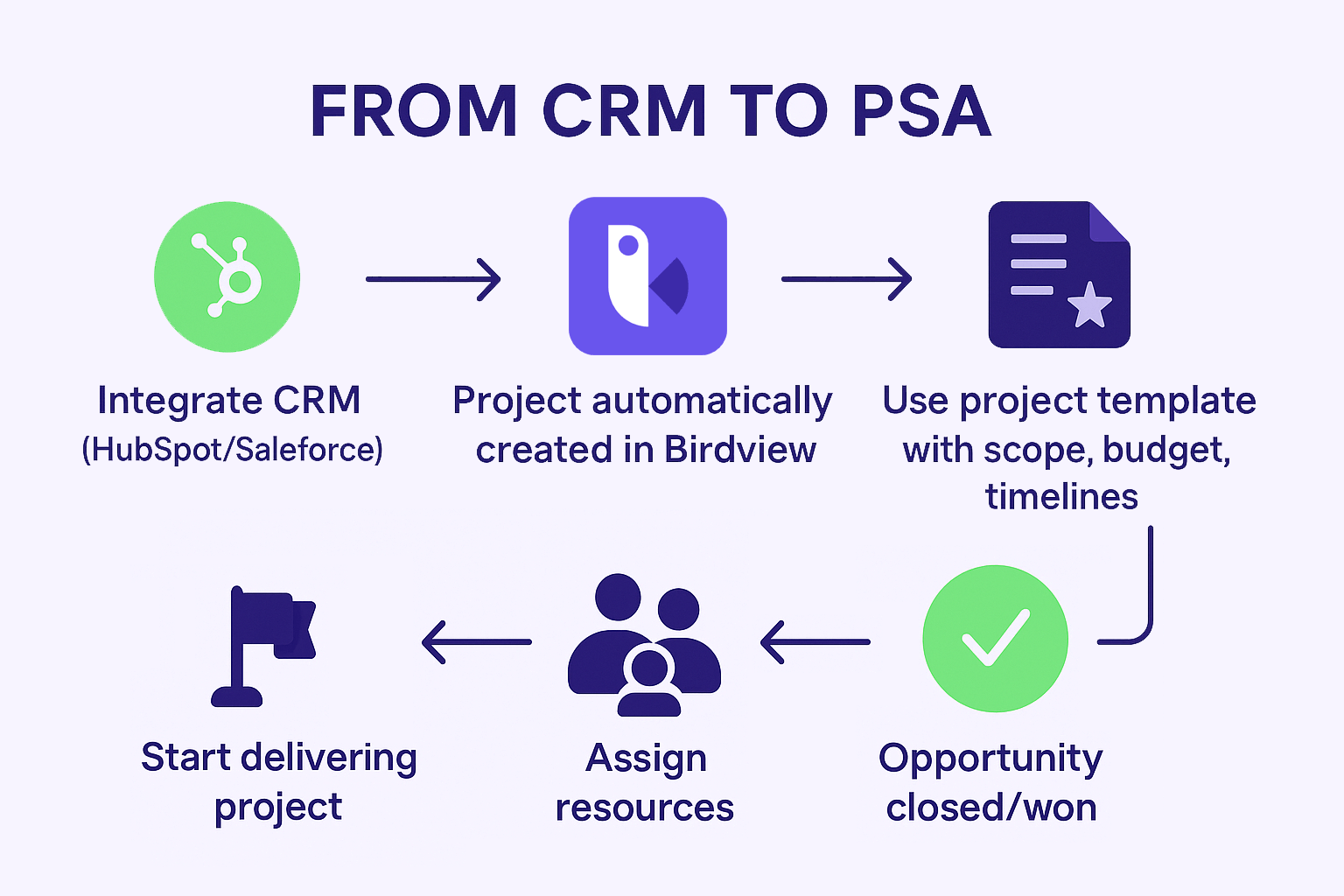Your sales team is working hard, filling the pipeline with promising opportunities. But what happens after a deal is won? Does project delivery begin immediately – or does the handoff stall because of manual data entry, duplicate conversations, or missing details?
In many professional services firms, the disconnect between sales and delivery systems creates costly delays. Without an integrated process, project kickoffs are postponed, resource planning is inaccurate, and revenue opportunities slip through the cracks. Even worse, new clients can experience a bumpy onboarding, which damages the trust your sales team worked hard to build.
According to a post on ResearchGate: “By exposing pipeline data from CRM to PSA systems, delivery teams can forecast future workload more accurately. This enables proactive hiring, smoother workload balancing, and fewer capacity conflicts.”
Now imagine a better scenario: the moment a deal is marked as “Closed-Won,” all essential information – client details, project scope, estimated budget, and required resources – flows instantly and automatically into your PSA software. Your delivery team is notified, the right template is launched, and your resource manager can see what‘s coming and prepare ahead of time.
That‘s the power of connecting your sales pipeline to your PSA system. It turns your sales-to-delivery handoff from a bottleneck into a growth enabler.
This article will explore the challenges of a disconnected sales process, highlight the key benefits of integrating your sales pipeline with PSA software, and show you how Birdview PSA bridges the gap, accelerating revenue, streamlining handoffs, and improving overall operational efficiency for your professional services organization.

The disconnect: why a siloed sales pipeline hurts delivery
In many professional services firms, the sales pipeline lives in one system – typically a CRM – while project delivery is managed elsewhere, often in spreadsheets, disconnected tools, or a separate PSA platform. On the surface, this seems manageable. But in reality, this siloed setup creates a chain reaction of inefficiencies that hurt both internal operations and client satisfaction.
Here‘s what happens when sales and delivery systems aren‘t connected:
- Delayed project initiation. Once a deal is closed, the project team often has to wait for someone to manually transfer opportunity details. This slows down kickoff, adds administrative overhead, and delays time-to-value for the client.
- Inaccurate resource forecasting. Without visibility into the sales pipeline, delivery teams are planning in the dark. They can‘t anticipate future workload or staff upcoming projects efficiently, leading to last-minute scrambles or unutilized capacity.
- Missed revenue opportunities. If your team doesn‘t have capacity because of poor forecasting or slow handoffs, you may have to decline work – even when there‘s strong demand. That means leaving revenue on the table.
- Poor client experience. When onboarding feels clunky – with repeated questions, missing information, or delays – it sends the wrong message. New clients notice the disconnect, and it can erode the trust your sales team worked so hard to earn.
- Inefficient resource allocation. Without knowing what‘s coming down the pipeline, resource managers are stuck reacting to whatever hits their inbox. Proactive scheduling becomes impossible, and team utilization suffers.
- Data silos and rework. Key details from the sales process – like project scope, special client requests, or stakeholder contacts – often don‘t make it to the delivery team. As a result, teams waste time asking the same questions or working with incomplete information.
The bottom line? A disconnected sales pipeline doesn‘t just slow you down – it limits your capacity, strains your people, and weakens your ability to grow.
You may also like: Professional Services Automation Software: A Practical Guide
Benefits of integrating sales pipeline with PSA software
When your sales pipeline is connected to your PSA software, everything changes. Instead of working in silos, your sales and delivery teams operate in sync – with real-time visibility, faster handoffs, and smarter planning. This integration isn‘t just about convenience. It‘s a strategic move that impacts profitability, forecasting accuracy, and client satisfaction.
Here‘s how your professional services firm benefits:
Faster quote-to-cash cycle. Automating the handoff from sales to project delivery eliminates delays. As soon as a deal is won, project creation begins – allowing your team to start work faster and invoice sooner. The result? Improved cash flow velocity.
Smarter resource forecasting. With visibility into upcoming opportunities, resource managers can forecast demand based on deals that are likely to close. That means fewer surprises, better staffing decisions, and more stable workloads.
Seamless sales-to-delivery handoff. Instead of manually collecting information from CRM records or chasing down account managers, your delivery team gets everything it needs – automatically. Client details, scope, budget, and timelines are transferred into your PSA, ready to go.
Optimized resource allocation. Knowing what‘s in the pipeline helps you assign the right people to the right projects at the right time. You can avoid overbooking, align skills with requirements, and improve utilization.
More accurate revenue forecasting. Linking your CRM with PSA software allows you to build forecasts based on real capacity and delivery timelines – not just pipeline value. This gives finance teams better insights for planning and growth.
Better client experience. A fast, smooth project kickoff reassures new clients that your delivery team is prepared and aligned. It builds on the trust established during the sales process and sets the tone for a successful engagement.
Data-driven decisions. Integrated data gives leadership the full picture: which opportunities align with delivery capacity, which ones are most profitable, and how to prioritize sales efforts accordingly.
In short, connecting your CRM and PSA isn‘t just a technical integration – it‘s an operational strategy that strengthens your entire project lifecycle.
6 best practices to connect your sales pipeline to PSA software
Implementing a seamless connection between your sales pipeline and PSA software requires collaboration between your sales and delivery teams:
- Align Sales & Delivery on Pipeline Stages: Ensure both teams agree on the definition and criteria for each stage in the sales pipeline, particularly the “Closed-Won” or “Likely to Close” stages that trigger project creation.
- Define Standard Project Templates: Create standardized project templates in Birdview PSA for common service packages or project types. This speeds up project creation when triggered by a won deal.
- Identify Essential Data Fields: Determine which data fields from your CRM opportunity are critical for project planning (e.g., estimated hours, key client contacts, project scope summary) and ensure they are mapped to transfer to Birdview PSA.
- Train Sales on Resource Estimation: Train your sales team on how to provide basic estimates of resource needs (e.g., hours by role) during the later stages of the sales process. This data is crucial for demand forecasting in Birdview PSA.
- Establish a Clear Handoff Process: Document the process for the handoff from sales to the delivery team once a deal is won, outlining roles, responsibilities, and using the automated project creation in Birdview PSA as the key trigger.
- Regularly Review Pipeline and Forecasts: Schedule regular meetings involving sales, delivery, and Resource Managers to review the sales pipeline in Birdview PSA, assess potential capacity impacts, and adjust forecasts.
5 key Birdview PSA features that connect your sales pipeline
Birdview PSA is purpose-built to bridge the gap between sales and delivery. With CRM integration at its core, it transforms sales handoffs into automated workflows that accelerate project kickoff, improve forecasting, and align your teams from day one.
Here are five key features that make this possible:
1. Automated project creation when a deal is won

Why it matters: No more manual project setup. Your delivery team gets a ready-to-launch project, prefilled with client details, scope, timeline, and budget – so execution starts immediately.

2. Estimate resource needs before the deal closes

Why it matters: Resource managers gain early visibility into upcoming demand and can begin planning capacity in advance – reducing last-minute scheduling chaos.

3. Forecast resource demand using pipeline data

Why it matters: You can identify capacity gaps months ahead and make proactive hiring or allocation decisions before they affect delivery.
4. Transfer key opportunity details into project plans

Why it matters: This eliminates manual entry and ensures the delivery team starts with all the context they need, without chasing down the sales team.
5. Forecast revenue based on pipeline and delivery capacity

Why it matters: Finance and leadership teams can align projections with actual delivery potential – avoiding overpromising and supporting better strategic planning.
Together, these features turn your disconnected sales pipeline into a fully integrated workflow – aligning people, processes, and profitability from the very first step.
Final thoughts:
A disconnected sales pipeline doesn‘t just slow you down – it creates friction, reduces forecasting accuracy, and limits your ability to scale. Every manual handoff, missed data point, or delayed kickoff adds up, costing your business time, revenue, and client trust.
By integrating your sales pipeline directly with your PSA software, you create a seamless flow of information from opportunity to execution. Project setup becomes automatic. Resource planning becomes proactive. Forecasting becomes grounded in reality. And your clients feel the difference from day one.
Birdview PSA gives you the tools to make this happen. With automated project creation, real-time pipeline visibility, and advanced resource forecasting, your teams can work as one – from the moment a deal is signed to successful project delivery.
See how we turn sales momentum into delivery success

Choosing the Best PSA Software for Professional Services
Onboarding vs. Implementation: Why Both Matter?
Client onboarding best practices, checklist, & strategies
Client project management: 9 tips and tricks to follow
FAQs
1. What is the benefit of integrating a sales pipeline with PSA software?
Integrating a sales pipeline with PSA software provides benefits like accelerated Quote-to-Cash cycle, improved resource forecasting and capacity planning, streamlined sales-to-delivery handoffs, enhanced resource allocation, more accurate revenue forecasting, improved client experience, and data-driven decision making.
2. How does connecting the sales pipeline to PSA improve resource forecasting?
Connecting the sales pipeline to PSA software improves resource forecasting by providing delivery teams with real-time visibility into potential future projects. This allows Resource Managers to forecast resource needs based on opportunities that are likely to close, enabling proactive staffing and capacity planning.
3. Can PSA software automate project creation from a CRM opportunity?
Yes, many PSA software solutions can integrate with a CRM (like Salesforce or HubSpot) to automatically create a project in the PSA system when an opportunity reaches a specific stage (e.g., “Closed-Won”), pulling in key client and scope details.
4. How does integrating the sales pipeline impact the sales-to-delivery handoff?
Integrating the sales pipeline streamlines the handoff by automating the transfer of key client and project information from the sales team (in the CRM) to the delivery team (in the PSA). This reduces manual data entry, delays, and the risk of information loss during the transition.
5. Does Birdview PSA integrate with CRMs like Salesforce or HubSpot?
Yes, Birdview PSA offers seamless integration with popular CRMs like Salesforce and HubSpot, allowing for automated project creation from opportunities and transfer of key data.
6. How can sales data from the pipeline be used for financial forecasting in PSA?
Sales data from the pipeline, including the value of potential projects and their estimated resource needs, can be used in PSA software to forecast future revenue. By combining this with the firm’s capacity to deliver, PSA provides a more realistic revenue forecast.
7. What kind of information is transferred from the sales pipeline to PSA during a handoff?
Typically, key information transferred includes client details, project scope summary, estimated budget, required roles or resources, key contacts, and any specific client requirements captured during the sales process.
8. Does connecting the sales pipeline to PSA improve the client experience?
Yes, connecting the sales pipeline leads to an improved client experience because a smooth and rapid handoff from sales to a well-prepared delivery team creates a positive first impression, builds trust, and sets the stage for a successful relationship.
9. Can Resource Managers see the potential impact of new sales opportunities on their team’s workload?
Yes, by connecting the sales pipeline to PSA, Resource Managers gain visibility into potential future projects and their estimated resource needs. This allows them to see the potential impact on their team’s capacity and workload months in advance.
10. Is connecting the sales pipeline to PSA only useful for large professional services firms?
No, connecting the sales pipeline to PSA can benefit professional services firms of all sizes. Even for smaller firms, streamlining the handoff, improving forecasting, and gaining visibility into future work can significantly improve efficiency and capacity to take on new business.



